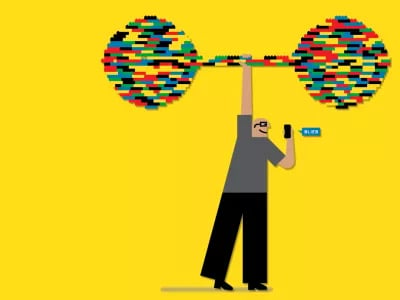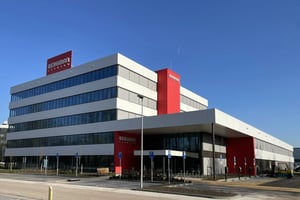Digitalisation is high on the to-do list of nearly every executive management team. But when you consider that companies have been systemising processes since the 1980s, it seems fair to ask: aren’t we done digitalising by now? Louis Rustenhoven, CEO of The IT Channel Company, discusses the difference between ‘dumb’ and ‘smart’ data and the future of digitalisation.
If you asked Louis Rustenhoven why it is that companies have been investing in digital systems for about four decades to support their business processes, yet they still struggle with it to this day, he'd answer: ‘Where do I begin?’ It turns out that while the question might be simple, the answer isn’t. This is mainly because there is a fundamental difference between ‘digital’ and ‘for digital purposes’, Rustenhoven explains.
‘What companies have essentially done these past decades is to digitalise parts of their business process’, he says. ‘I refer to this as “island digitalisation”. This type of digitalisation will help you to automate specific tasks, but it doesn’t do what you really want, which is to optimise the entire chain from beginning to end. What’s more, companies now realise there are barriers between all the old sub-systems, and these barriers make it very difficult to adopt an integrated approach to problem-solving. We’ve only been looking at automation from this holistic perspective for the last five to ten years.’
This island automation of the past decades is exactly why companies are nowhere near “done” when it comes to digitalisation’, Rustenhoven says. ‘The larger and more complex the company, the more legacy systems they’re likely to have, and you can’t replace those overnight. Instead, companies extract data from different islands and then link the data, so they can control the entire chain, albeit with a workaround. This approach doesn’t have to be limited to the company; you can also do this with clients and suppliers.’
Lego box
Linking data from different sub-systems is also made possible, to a considerable extent, by the emergence of cloud computing, Rustenhoven says. ‘The cloud is essentially a large receptacle where all data can be collected. A second important development is that a new generation of software has become available which can distill useful management information from a mass of data, in the form of reports. Consequently, you see that companies are gaining different insights and making other decisions.’
The nifty thing is that the new generation of software mostly takes on the form of what are known as ‘low-code’ or ‘no-code’ apps, and users with no coding experience can build them. ‘In fact, you buy a kind of “Lego box” containing different coding blocks,’ Rustenhoven says. ‘We offer one-day workshops in which we teach our partners how to arrange the blocks to create a working app. This is already widely used for various reporting tools and dashboards in companies, and to build apps to allow you to automate simple processes. Think, for example, of expense-tracking apps or time-tracking apps. They’re all cloud-based, which means they are accessible from anywhere and any device.’
This ‘low-code’ or ‘no-code’ trend is also the main driver behind the approach to software development known as ‘citizen development’ (see inset), which means that marketers no longer need assistance from the IT department to automate something in a jiffy. According to Rustenhoven, this type of technology is increasingly used to replace old, often custom-made, systems. When asked if this trend means the end of the traditional IT department, he says: ‘We’re actually seeing a change in the role of the IT department. Because, while there might be Lego boxes for users, there are also guidelines in place for use and registration. The IT department is responsible for ensuring these guidelines are met, because things must remain manageable. You could say that the business and the IT department are growing closer due to this trend, when in fact IT remains in control because it continues to set the architecture guidelines.’
More grip
But the long-term goal for many companies is to switch to one system that supports the overall chain — from supplier to customer. Rustenhoven: ‘With a growing number of businesses moving online, it’s good to have online ordering systems linked directly to an inventory system and your supplier’s system, for example.’ Another factor is that companies are increasingly thinking from the entire Customer Journey perspective. Research shows that by the time a customer visits your store, they have already gone through 60% of their decision-making process. Companies would like more control over that invisible pre-purchase process. They want to learn about the customer’s previous online experiences and history, and their level of knowledge, so they can anticipate and respond to them effectively. That’s only possible when you have all the data stored in a single system.’
Empowering the citizen-developer movement
Business intelligence apps are advancing and gaining popularity within SMEs and large organisations alike. Various companies, including IKEA, PepsiCo, Eneco, Oasen and Rabobank, have even set up competence centres to teach employees to develop apps. The importance of this development is also clear from the fact that major players are now also entering the low-code market. For example, Siemens acquired Dutch low-code specialist Mendix last year for more than EUR 600 million, and Microsoft has already racked up more than $1.5 billion in revenue from (low-code) PowerApps. Microsoft CEO Satya Nadella believes this is only the beginning. ‘It will represent an explosion in customer-built applications unlike anything the business world has ever seen. 500 million new apps will get created in the next five years — more than the total created in the last forty. The citizen-developer movement is here, and we are empowering it’, says Nadella.
Another NPM portfolio company, Conclusion, has also set up a low-code development unit, using the above-mentioned Mendix platform. Daniëlle Graat, director of Conclusion Low Code Company: ‘Low-code development is definitely here to stay. Gartner even expects that the development of low-code applications will account for more than 65% of all application development activities by 2024, and we can see this happening, too. For our clients, low-code has become a strategic choice when creating custom applications. Low-code is ideal for clients who want to experiment with launching a new product or service in the market quickly: you can program a demo in no time and, based on feedback, decide if you want to continue or halt development. But low-code is also perfect for improving operational efficiency or building client portals or personal online environments. We also use it quite a lot to “customise” existing standard systems for financial accounts, production planning, order administration, staff administration and the like.’
According to Graat, the terms ‘no-code’ and ‘low-code’ can be misleading: people often use them interchangeably, and there is no uniform definition. In practice, platforms that identify as no-code focus more on citizen-developers, while low-code platforms are geared more to experienced developers.
About The IT Channel Company
The IT Channel Company (TICC) specialises in software development, training and distribution of Microsoft products to ICT retailers. Since its establishment in 2013, TICC has grown into a mature organisation with more than 150 employees that provide services in more than 20 countries. With its ‘Digital & Technology’ investment line, NPM Capital has been involved in TICC since its inception and has actively supported the company’s rapid growth.













